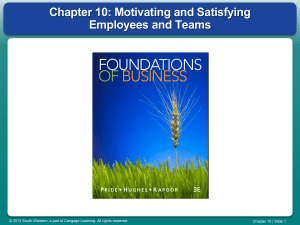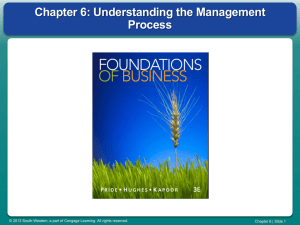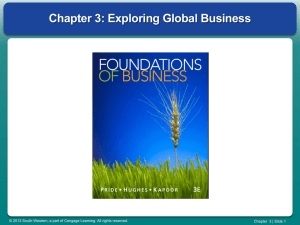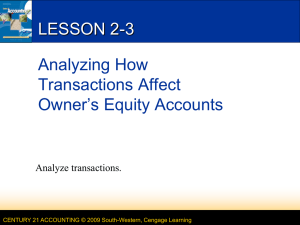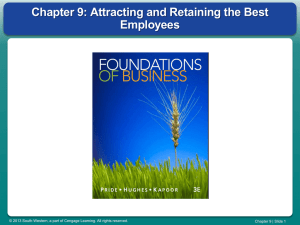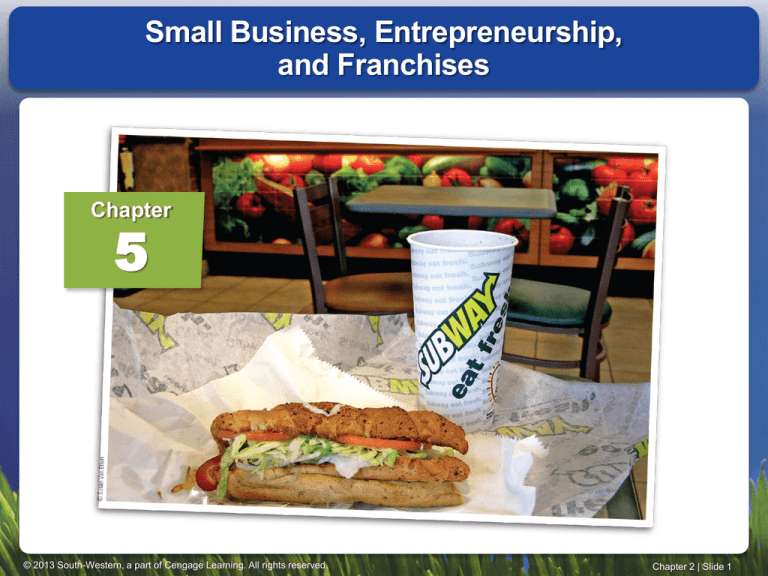
Small Business, Entrepreneurship,
and Franchises
Chapter
5
© 2013 South-Western, a part of Cengage Learning. All rights reserved.
Chapter 2 | Slide 1
Small Business: A Profile
A business that is independently owned
and operated for profit and is not dominant
in its field
© 2013 South-Western, a part of Cengage Learning. All rights reserved.
Chapter 2 | Slide 2
Industry Group-Size Standards
© 2013 South-Western, a part of Cengage Learning. All rights reserved.
Chapter 2 | Slide 3
Small Business: A Profile (cont.)
Important facts
• In the last decade, the number of small businesses increased
49%.
• 70% of new businesses survive at least two years, about 50%
survive at least five years, and 31% survive at least seven
years.
• The primary reason for these failures is due to poor
management stemming from a lack of business know-how.
• Small businesses provide over 50% of the jobs in the U.S.
© 2013 South-Western, a part of Cengage Learning. All rights reserved.
Chapter 2 | Slide 4
The Entrepreneurs
Characteristics
•
•
•
•
•
•
The “entrepreneurial spirit”
The desire for independence
The desire to determine one’s own destiny
The willingness to find and accept a challenge
Personal background
Age-most are 24-44 years old
Motivation
•
•
•
•
•
“Had enough” of working for someone else
High-tech opportunities, especially for teens
Losing a job and deciding to start a business
An idea for a new product
An opportunity presents itself
© 2013 South-Western, a part of Cengage Learning. All rights reserved.
Chapter 2 | Slide 5
The People in Small Businesses:
The Entrepreneurs (cont.)
Women
• Owned at least 50% of small businesses in 2008
• Women have less risk of failure than average
Teenagers
• High-tech entrepreneurship is exploding
• Face unique pressures juggling schoolwork, social lives,
business workload
• Need skills for planning, persistence, patience,
people management, generating profit
Successful entrepreneurs under age 30
© 2013 South-Western, a part of Cengage Learning. All rights reserved.
Chapter 2 | Slide 6
The Pros and Cons of Smallness
Advantages
Personal relationships with
customers and employees
Ability to adapt to change
Simplified recordkeeping
Independence
Advantages of sole
proprietorships
Disadvantages
Risk of failure
Limited potential
Limited ability to raise
capital
• Keeping all profits
• Ease and low cost of
going into business
• Keeping business
information secret
© 2013 South-Western, a part of Cengage Learning. All rights reserved.
Guy Kawasaki from Apple
“Make Meaning”
Chapter 2 | Slide 7
Sources of Capital for Entrepreneurs
© 2013 South-Western, a part of Cengage Learning. All rights reserved.
Chapter 2 | Slide 8
Developing a Business Plan
Business plan—a carefully constructed guide for
the person starting a business
Three basic purposes
• Communication
• Management
• Planning
Banking officials’ and investors’ questions
• What is the nature and mission of the new venture?
• Why is it a good idea?
• What are the goals?
• How much will it cost?
© 2013 South-Western, a part of Cengage Learning. All rights reserved.
Chapter 2 | Slide 9
The Small Business Administration
A governmental agency that assists, counsels, and
protects the interests of small business in the U.S.
SBA management assistance
• Management courses and workshops
• Service Corps of Retired Executives (SCORE)
• Help for minority-owned small businesses
• Small-business institutes (SBIs)
• Small-business development centers (SBDCs)
• SBA publications
© 2013 South-Western, a part of Cengage Learning. All rights reserved.
Chapter 2 | Slide 10
The Small Business Administration (cont.)
SBA financial assistance
• Regular business loans
– Loans made by private banks but partially guaranteed
by the SBA
• Small-business investment companies
– Venture capital: money invested in small firms that
have the potential to become very successful
© 2013 South-Western, a part of Cengage Learning. All rights reserved.
Chapter 2 | Slide 11
Franchising
Franchise
• A license to operate an individually owned business
as though it were part of a chain of outlets or stores
Franchising
• The actual granting of a franchise
Franchisor
• An individual or organization granting a franchise
Franchisee
• A person or organization purchasing a franchise
© 2013 South-Western, a part of Cengage Learning. All rights reserved.
Chapter 2 | Slide 12
What Is Franchising?
Franchise
Agreement
Franchisor
Franchisee
© 2013 South-Western, a part of Cengage Learning. All rights reserved.
John Q.
Look at Dunkin’ Donuts
Franchise Agreement
Chapter 2 | Slide 13
Basic Rights & Obligations Delineated
in a Franchise Agreement
© 2013 South-Western, a part of Cengage Learning. All rights reserved.
Chapter 2 | Slide 14
The Growth of Franchising
The growth of franchising
• Franchising has expanded with the growth of the
fast-food industry.
• Franchising is attracting more women and minority
business owners than ever before.
• Dual-branded franchising, in which two franchisors
offer their products together, is a new trend.
–
Example: Taco Bell and KFC
© 2013 South-Western, a part of Cengage Learning. All rights reserved.
Chapter 2 | Slide 15
The Growth of Franchising (cont.)
Are franchises successful?
• The success rate for franchises is significantly higher
than that for other small businesses.
• The vast majority, 94%, of franchise owners report
that they are successful.
• Too rapid expansion, inadequate capital or
management skills, or other problems can cause
franchises to fail.
© 2013 South-Western, a part of Cengage Learning. All rights reserved.
Chapter 2 | Slide 16
Entrepreneur’s Ten Franchises in 2011
Source: http://www.entrepreneur.com/franchise500/index.html (accessed March 15, 2011).
© 2013 South-Western, a part of Cengage Learning. All rights reserved.
Chapter 2 | Slide 17
Advantages of Franchising
To the franchisor
• Fast and well controlled
•
•
•
•
distribution of its products
No need to construct and
operate its own outlets
More working capital
available for expanded
production and advertising
Franchising agreements
maintain product and quality
standards
Motivated work force of
franchisees
© 2013 South-Western, a part of Cengage Learning. All rights reserved.
To the franchisee
• Opportunity to start a
proven business with
limited capital
• Guaranteed customers
• Franchisor available for
advice and guidance
• Materials for local
promotional campaigns
and participation in
national campaigns
• Cost savings when
purchasing in cooperation
with other franchisees
Chapter 2 | Slide 18
Disadvantages of Franchising
To the franchisor
• Failure of the franchisee
to operate franchise properly
• Disputes with and lawsuits
by franchisees over the
terms of the franchise
© 2013 South-Western, a part of Cengage Learning. All rights reserved.
To the franchisee
• Franchisor retains a large
amount of control over the
franchisee’s activities
• Franchisor opening
competing franchises within
the franchisee’s market
Chapter 2 | Slide 19
Qualities Franchisors
Seek in Franchisee
© 2013 South-Western, a part of Cengage Learning. All rights reserved.
Chapter 2 | Slide 20
Chapter Quiz
1. Which one of the following would most likely
be classified as a service industry?
A.
B.
C.
D.
E.
Grocery store
Jewelry store
Pet shop
Dry cleaning shop
Clothing store
© 2013 South-Western, a part of Cengage Learning. All rights reserved.
Chapter 2 | Slide 21
Chapter Quiz
2. Roger Jones, a graduate business student, has
decided to open his own consulting firm. Since he
is an intelligent and hard-working student with
previous management experience, Roger feels he
is well prepared to succeed since more new
businesses fail due to
A. a lack of adequate financing.
B. low consumer demand for their products.
C. hostile competition.
D. a lack of owner commitment.
E. mismanagement and lack of business know-how.
© 2013 South-Western, a part of Cengage Learning. All rights reserved.
Chapter 2 | Slide 22
Chapter Quiz
3. A license to operate an individually owned
business as if it were part of a chain of outlets
or stores is called a
A.
B.
C.
D.
E.
joint venture.
syndicate.
franchise.
SCORE.
small-business development center.
© 2013 South-Western, a part of Cengage Learning. All rights reserved.
Chapter 2 | Slide 23
Chapter Quiz
4. Jim Moniz is contemplating obtaining a
franchise. He would like to purchase a
franchise in an industry that has had
extensive success with franchising in the
past. All of the following are possible choices
for Jim except
A.
B.
C.
D.
E.
a fast-food industry.
the semiconductor industry.
filling stations.
car dealerships.
the soft-drink industry.
© 2013 South-Western, a part of Cengage Learning. All rights reserved.
Chapter 2 | Slide 24

